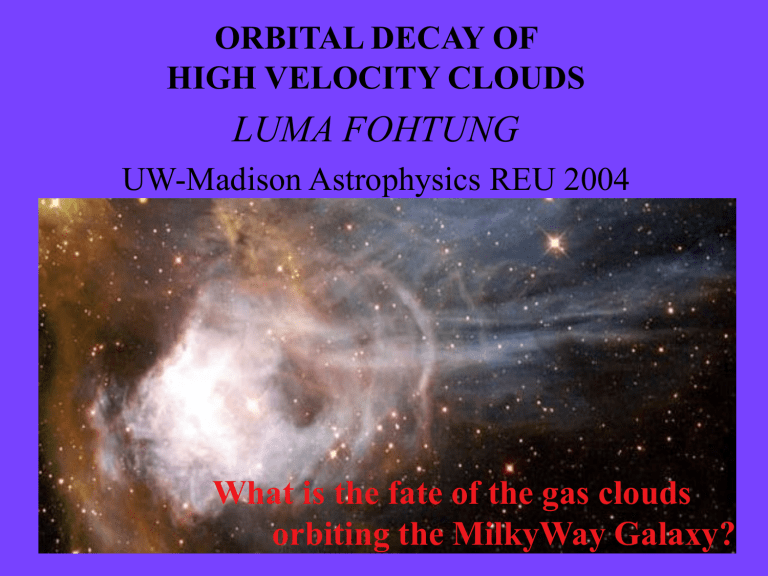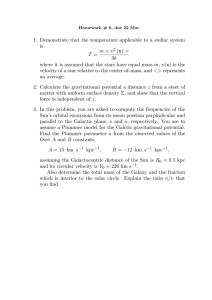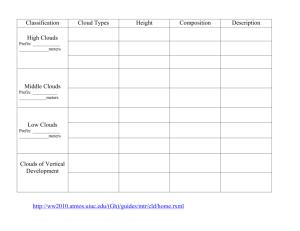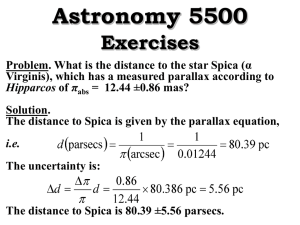My Final Presentation - UW

ORBITAL DECAY OF
HIGH VELOCITY CLOUDS
LUMA FOHTUNG
UW-Madison Astrophysics REU 2004
What is the fate of the gas clouds orbiting the MilkyWay Galaxy?
HVC Overview
Note
“stretched” appearance!
Contours in above HI image at Column density ~2, 20, 40 x 10 18 cm -2 (Wakker et al
2003)
Definition : HI with velocities that cannot be due to Galactic rotation.
Global Distribution: Covering over 40% of sky (depending on sensitivity).
Distances: 1.5-4 kpc (Complex M) to 50 kpc (Magellanic Stream). Many at unknown distance
High Velocity Cloud “Streams”
What determines the orbit of a
HVC?
• Gravity and random motions only?
50 kpc
Schematic diagram of Magellanic Stream
• Drag forces due to gaseous halo and disk of
Galaxy ?
How long does it take a HVC to merge with the
Galaxy? What happens during the process?
My Project
Goal: Develop numerical models of orbital motion for high velocity clouds
Tools: Fortran code (for the models) and IDL (to view the output)
Method: Write programs, generate the output, use plots to check our results, and debugging… Lots of debugging…
Initial Conditions for Program
• Calculate the orbit of a “test cloud” of 10,000 points.
• Specify average position and velocity of test cloud.
(x, y, z) average
(v x
, v y
, v z
) average
• Specify Gaussian scale length for cloud: s
R
• Specify Gaussian velocity dispersion for cloud: s v
• Set up information on desired time step and stopping time.
• Choose model for gravitational field of Galaxy
(Dehnen & Binney 1998 “Mass Models of the Milky
Way”)
Numerical Methods
Random number generator:
Needed to set up randomized position and velocity for test clouds.
Differential equation solver:
Needed to evolve equations of motion for test clouds. I used a
Runge-Kutta method ( Numerical Recipes ). dx dt
v x d v x dt
g x dy
v y d v y g y dt dt dz
v z d v dt dt g ( x , y , z )
( g x z
g z
, g y
, g z
)
Equations of motion:
Set of six coupled differential equations.
Before
An example run
After
Checking the calculations
1. I checked our differential equation solver with simple (not coupled) equations with known solution.
2. I used the Runge-Kutta method and gravitational field of a point source to calculate the orbit of the Sun.
3. Using a Galactic mass model, we calculated orbit for the current position and velocity of the Sun.
4. Checked total energy and orbital angular momentum. Both were conserved to within 0.01%.
Kinetic
Energy
Total
Potential
Check: Energy vs. time
So far…
• Development of the FORTRAN code to calculate orbits for clouds.
• Development of IDL routines to visualize output.
• Initializing using solar type orbits.
• Trace of resulting cloud and stretching of initial cloud.
Cases
X i
Y i
Z i
V
X,i
V
Y,i
(kpc) (kpc) (kpc) (km/s) (km/s)
Run1 0 8.5
0 220 0
Run2 0 8.5
0 220 0
Run3 0 8.5
0 220 0
Run4 0 8.5
0 220 0
Run5 0 8.5
0 220 0
Run6 0 0 8.5
220 0
Run7 0 12 0 220 0
Run8 0 20 8.5
220 0
Run9 0 0 8.5
280 0
Run10 0 0 8.5
160 0
Run11 0 8.5
0 280 0
Run12 0 8.5
0 160 0
0
0
0
0
0
V
Z,i
(km/s)
0
0
0
0
0
0
0 s
R s
V
Gravity
Model
(kpc) (km/s)
0.5
20 DB
0.5
40 DB
0.5
10 DB
1.0
20 DB
0.1
20 DB
0.5
20 DB
0.5
20 DB
0.5
20 DB
0.5
20 DB
0.5
20 DB
0.5
20 DB
0.5
20 DB
Time Step
(Myr)
0.2
0.2
0.2
0.2
0.2
0.2
0.2
0.2
0.2
0.2
0.2
0.2
These cases are to “practice” with orbits similar to that of the Sun, and experiment with different parameters.
Increase v dispersion
Polar orbit
Comparison of Cases
QuickTime™ and a
Photo - JPEG decompressor are needed to see this picture.
Run 1: Standard Case
Effect of Increasing
s v
QuickTime™ and a
Photo - JPEG decompressor are needed to see this picture.
Run 2: Double velocity dispersion to 40 km/s
Polar orbit
QuickTime™ and a
Photo - JPEG decompressor are needed to see this picture.
Run 6: Orbit in XZ plane
What I have learnt….
-A LOT of programming (IDL and Fortran)
-a better insight about astronomy
A WHOLE LOT OF PATIENCE
Future work
Study the orbits of clouds much further away from the
Galaxy, objects similar to the Magellanic Stream.
Add and test the effects of gaseous drag on our test particles. Experiment with different density distributions and include the effect of possible outflows from the center of the Galaxy.
Check on the importance of self-gravity for the cloud.
Consider how magnetic effects would alter drag on clouds.
Acknowledgements
• My advisor: Dr Bob Benjamin
• UW Madison REU program
• NASA











